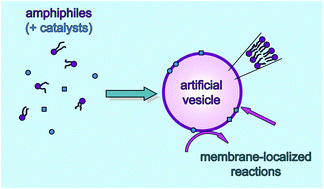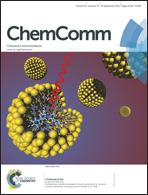Emergent properties arising from the assembly of amphiphiles. Artificial vesicle membranes as reaction promoters and regulators†
Abstract
This article deals with artificial vesicles and their membranes as reaction promoters and regulators. Among the various molecular assemblies which can form in an aqueous medium from amphiphilic molecules, vesicle systems are unique. Vesicles compartmentalize the aqueous solution in which they exist, independent on whether the vesicles are biological vesicles (existing in living systems) or whether they are artificial vesicles (formed in vitro from natural or synthetic amphiphiles). After the formation of artificial vesicles, their aqueous interior (the endovesicular volume) may become – or may be made – chemically different from the external medium (the exovesicular solution), depending on how the vesicles are prepared. The existence of differences between endo- and exovesicular composition is one of the features on the basis of which biological vesicles contribute to the complex functioning of living organisms. Furthermore, artificial vesicles can be formed from mixtures of amphiphiles in such a way that the vesicle membranes become molecularly, compositionally and organizationally highly complex, similarly to the lipidic matrix of biological membranes. All the various properties of artificial vesicles as membranous compartment systems emerge from molecular assembly as these properties are not present in the individual molecules the system is composed of. One particular emergent property of vesicle membranes is their possible functioning as promoters and regulators of chemical reactions caused by the localization of reaction components, and possibly catalysts, within or on the surface of the membranes. This specific feature is reviewed and highlighted with a few selected examples which range from the promotion of decarboxylation reactions, the selective binding of DNA or RNA to suitable vesicle membranes, and the reactivation of fragmented enzymes to the regulation of the enzymatic synthesis of polymers. Such type of emergent properties of vesicle membranes may have been important for the prebiological evolution of protocells, the hypothetical compartment systems preceding the first cells in those chemical and physico-chemical processes that led to the origin of life.

- This article is part of the themed collection: Systems Chemistry

 Please wait while we load your content...
Please wait while we load your content...